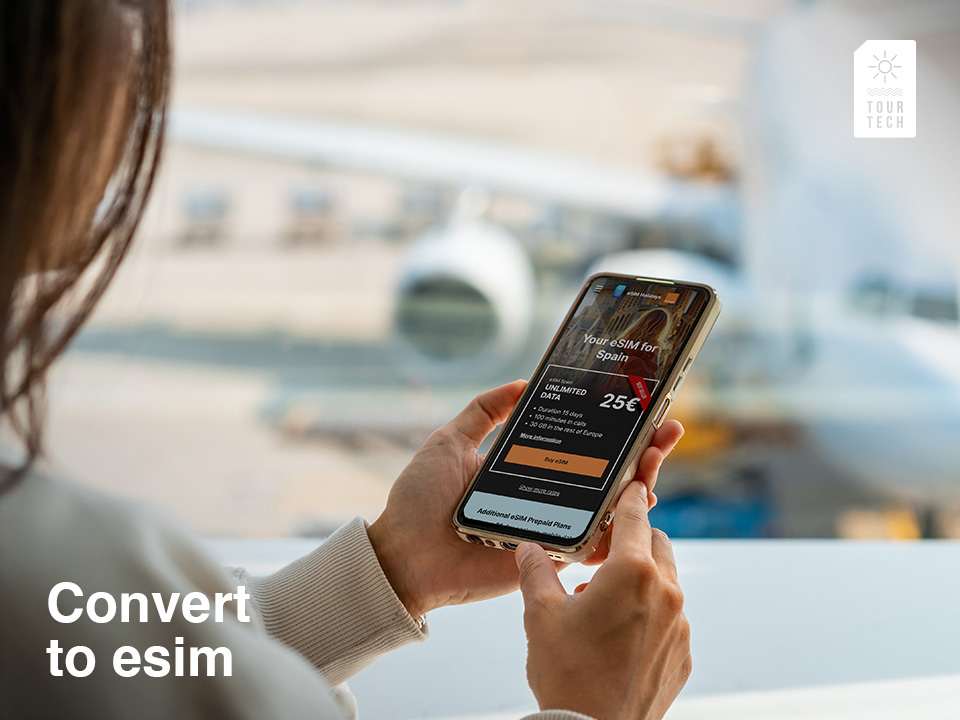The shift to eSIMs is happening. The introduction of eSIM technology in 2011 has transformed the mobile phone landscape, making it easier to manage subscriptions plans and providing a better user experience. With the rise of eSIM options and device compatibility, it’s clear that this technology is here to stay.
Travel eSIM plans are already a reality. They provide a reliable solution to avoid roaming costs and manage travel budgets, offering users worldwide an ideal data plan to stay connected on their vacations. Orange eSIM Holidays is the perfect example of a travel eSIM. For just €25, you’ll get 30GB of data to use anywhere in the 27 countries of the European Union, Norway and Liechtenstein.
Take a step into the future of mobile technology and convert to eSIM. Enjoy the convenience and endless advantages of this technology. Let’s analyze the benefits and disadvantages of eSIMs.
Contents / Contenidos
Understanding eSIMs
An eSIM, short for embedded SIM, is a virtual SIM card that is embedded in your mobile phone and can be programmed with different mobile network profiles. This technology eliminates the need for a physical SIM card and allows for seamless switching between mobile carriers with no need to swap out physical SIM cards. ESIMs work by storing multiple cellular network profiles on the device and enabling the user to switch between plans as needed. The process involves downloading a new network profile to the eSIM chip, activating it, and then using the new network services. This allows for greater flexibility and convenience for users, especially for those who travel frequently or require multiple mobile plans.
ESIMs: Supported devices and carriers
ESIM technology is supported by a growing number of devices and carriers worldwide. Popular phones such as the iPhone models since the iPhone 11S, Google Pixel 4, and Samsung Galaxy S20 are eSIM compatible. You can access the eSIM carrier’s list of compatible devices available on their website to check if you’ll be able to use their eSIM. Leading mobile carriers globally, including Vodafone, Orange, AT&T, and Verizon, offer eSIM support for convenient service access without a physical SIM card.
Advantages of eSIMs vs. traditional physical SIM cards
Versatility
The primary benefit of eSIM plans over traditional physical SIM cards is the convenience of switching between different carriers with no need to physically swap out a SIM card. This is a tremendous advantage, since you’re automatically avoiding the possibility of losing the card or breaking it. By storing several eSIM profiles in your mobile phone, you’ll be able to choose which one you want to use by selecting it on your settings app.
Physical space
ESIM technology enables devices to be smaller and more streamlined, as there is no need for a physical SIM card slot. This means bigger batteries, space for other useful components or reducing the size of the mobile phone.
Convenience
Purchasing an eSIM is extremely convenient. You can do the entire process online, and you won’t have to leave your couch to get the eSIM card. You can download an eSIM profile onto your phone by scanning a QR code and have it installed on your device in a matter of minutes.
International availability
This technology also facilitates easier international travel, as you can simply download a new cellular plan without having to acquire a physical local SIM card. With an eSIM, you can easily switch from your home carrier to a local cellular network in a foreign country, and you can get local rates for a limited time without having to search for a local SIM vendor.
Disadvantages of eSIMs
Before making the switch to eSIMs, it is important to address some minor inconveniences with this technology so you can make an informed decision.
ESIMs have limited device compatibility since only certain high-end mobile phones offer eSIM support, you can check if your device is eSIM compatible by searching for it in this list. There’s also the potential difficulty of transferring the eSIM to a new phone, since, unlike a physical SIM card, you can’t extract an eSIM card. You’ll need to contact the eSIM carrier to reprogram the card on your device.
The availability of eSIM support is also limited by the network provider, and some countries have restricted or limited their usage, citing security concerns since it could be susceptible to hacking or unauthorized access.
On the whole, the advantages outweigh the disadvantages, and the market trend clearly shows that eSIMs will become the industry standard within a few years.

Travel eSIMs: Bypassing roaming fees
Travel eSIM plans offer significant advantages for modern travelers. They provide the convenience of easily accessing local mobile networks, taking advantage of local rates and avoiding roaming fees from their home carriers.
You can download a travel eSIM from your own home computer, and have it ready for activation as soon as you land on your next destination. This eliminates the hassle of searching for a physical SIM card in a foreign country. Additionally, eSIMs can support multiple mobile phone profiles, allowing travelers to maintain their home number while using a local number for cost-effective communication.
The flexibility and convenience of travel eSIM plans make them a practical choice for international travelers.
Travel eSIM plans can even offer regional coverage, allowing you to visit several countries with the same eSIM plan. For example, with a regional eSIM like Orange eSIM Holidays, you can visit Europe with one eSIM. This card offers 30GB of data, 100 minutes of voice calls and coverage in any of the 27 countries of the European Union, Norway and Liechtenstein for just €25.
How to make the switch to eSIMs
To convert to eSIM, contact your mobile carrier to ensure your device is eSIM-compatible or check the compatibility list on their website. Purchase an eSIM activation kit or a QR code from your carrier or a third-party provider and follow the instructions provided to download and install the eSIM profile onto your device. Once activated, you can manage your eSIM settings directly on your device and enjoy the convenience of an embedded SIM card.
In a nutshell
Making the switch to eSIM will offer you a seamless experience, especially if you’re looking for convenience and flexibility in your mobile connectivity. With its potential to streamline the activation process and support multiple cellular networks on a single device, eSIMs represent a significant leap forward in mobile technology. By embracing eSIM technology, you’ll be choosing a more efficient and hassle-free mobile experience. A travel eSIM can be the perfect opportunity for you to make the first contact with this technology. Who knows, maybe you’ll love it so much that you’ll convert to eSIM when you return home.
Buy Orange eSIM Holidays
FAQs
Can I use an eSIM and a SIM card at the same time?
Yes. Since you can download and store multiple eSIM profiles on your mobile phone without extracting your SIM card, you can use both your SIM card and an eSIM plan at the same time. Just like with dual SIMs, you can select your eSIM as your data provider and keep your SIM card for calls and SMS.
Should I install a travel eSIM before leaving my country?
You can get an eSIM from anywhere in the world as long as you have internet access, but if you want to avoid activation issues, we recommend that you activate your travel eSIM only in the region where it provides coverage. You can install your travel eSIM before boarding the flight, and then after you’ve reached your destination, deactivate the data roaming from your primary SIM and activate it on your travel eSIM plan.
Do eSIMs drain more battery?
No, using an eSIM doesn’t use more battery than using a SIM card. However, by keeping two profiles active, your battery life will suffer, especially because your mobile phone needs more processing power. The same would happen if you were using two SIM cards at the same time, so the fact that one of them is an eSIM is irrelevant.
Are eSIMs slower than SIM cards?
No, whether you use an eSIM or a physical SIM card doesn’t affect your mobile network speed. The speed of your mobile connection depends on several factors like quality of the coverage, type of service plan or cellular network congestion, but the fact that you’re using an eSIM or a physical SIM card has no effect on the speed of your connection.


